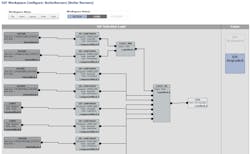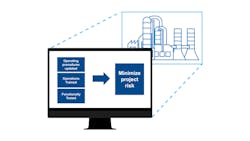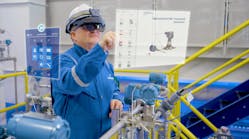Optimizing preventive maintenance drives competitive advantage
Process manufacturers are operating differently than they did even five short years ago. A global pandemic, supply chain crises and a stronger public focus on sustainability have increased the need for plants across an organization to all operate at peak performance. Every link in the chain is essential, so in most cases every plant across the enterprise needs to step up to meet new goals.
Accomplishing these goals requires changes in the way plants operate in terms of equipment, processes and personnel. But these changes often seem at odds with the needs of maintenance staff who, as part of their preventive maintenance strategies, require consistency so they can trust equipment to run as expected for a certain length of time. Change cascades across the organization, and if initiatives do not take the needs of the reliability team into account, it can cause frustration, lost revenue and even safety incidents.
Fortunately, predictive technologies are now available that can help ease the transition to new and more efficient equipment operation. By improving collection of data from process and balance-of-plant assets, and by connecting that data to modern industrial software solutions, process manufacturers can empower operators to innovate, helping meet sustainability and efficiency goals, while simultaneously improving the entire preventive maintenance process.
Rescuing stranded data
At the heart of improving plant performance is good data. A reliability team that cannot see the health of its assets is often surprised when they fail. Surprise is the antithesis of a successful reliability program. These unexpected equipment failures can lead to unplanned outages, which are expensive and time consuming to remedy, and repair and maintenance is much more expensive than with planned work.
Many teams do not collect all the data they need due to a confluence of factors. First, process manufacturing plants can be large and contain numerous hazardous areas. These physical barriers increase the time and planning it takes to collect data. If it takes an hour or more to drive out to an asset to inspect it with a handheld analyzer, the asset is likely to be checked infrequently, if at all. Or if it takes an hour to get the gear and safety checks done to enter a hazardous area to check an asset, it is similarly unlikely to happen regularly.
But even in the rare case a plant has the time and resources to regularly drive to remote assets and perform the critical safety steps required for accessing hazardous areas, in today’s plant environment teams rarely have the spare personnel to do so. Retirements have claimed many of the plant’s most experienced personnel, and process manufacturers frequently run with skeleton crews who work extra hours just to get all the basic tasks done. Rarely will they have the free personnel to perform manual rounds, especially for equipment located remotely, or in hazardous areas.
The solution is improving preventive maintenance by implementing predictive technologies across the entire facility. Today’s most successful process manufacturers are moving away from traditional route-based maintenance and instead embracing continuous monitoring technologies that tie directly into the plant’s supervisory control and data acquisition (SCADA) system.
The most modern SCADA implementations are multi-tenant, software-as-a-service systems designed to be easier to install and connect to pervasive sensing technologies. These systems can get data directly from assets via nodes, and easily move that data to the cloud using a wide variety of communication technologies, including wireless, cellular, satellite and more (Figure 1).
Once critical asset health data is in the cloud, teams can easily use it in modern industrial software applications to provide for better safety and maintenance through advanced analytics and highly accurate simulation.
Improving safety with predictive maintenance software
Every plant values production, but even more important is safety. An organization’s personnel are its most critical assets, so the reliability of safety systems and related equipment must always come first. However, one thing many teams do not realize is that properly functioning safety systems also improve performance.
Consider a facility’s safety showers. If the showers are operating every two hours, something is clearly wrong. Perhaps a pump is pumping too much or not enough, or maybe the pressure is too high or too low. Whatever the root cause, something is wrong, and not fixing it presents a safety risk. In addition, some systems, such as high temperature attemperators, rely on water resources that might not refresh fast enough, risking them being unavailable when truly needed. Unaddressed issues also waste resources, such as water in the case of the safety showers. Plus, depending on the system, teams may need to slow or stop production while they are dealing with the problem, or may be ineffectively using their limited personnel trying to clean up and troubleshoot in response to each incident.
To avoid these problems, today’s innovators are using modern sensing technologies coupled with industrial software to track the integrity of safety systems in their facilities, and then instantly report aberrations through the SCADA system. Safety instrumented function (SIF) tracking software can automatically identify safety systems in a degraded state, helping plant personnel resolve issues before the operation becomes unsafe (Figure 2).
Operators can use the software to verify the integrity of the safety systems they are responsible for, and, if issues are identified, help prioritize work orders to restore the integrity of that system. Operators can also use SIF tracking software to verify that bypasses are cleared, ensuring safety systems can perform effectively when called upon.
Data-driven maintenance
When safety systems are securely monitored, plant personnel can turn their attention to the many pieces of rotating equipment across the facility — its pumps, compressors, motors, fans and more. Historically, plants relied on technicians with decades of experience to examine these assets and identify when something was beginning to degrade. Often, those technicians could even hazard a reasonable guess as to how long it would take the asset to fail.
Today, few plants have a deep bench of experienced personnel. But what they do have is months, years or even decades of data stored in process historians. Often, teams have baselines and metrics from peak performance of rotating assets when they were brand new. This data is the ideal foundation for an analytics program using artificial intelligence (AI) and machine learning-driven (ML) asset monitoring software.
AI and ML-driven software takes all the data from a process historian and creates a baseline of functionality and a set of metrics for how the asset should perform. In real-time, the software can take newly collected asset health data and monitor it for deviations from the baseline. When a deviation is detected, plant personnel receive early, accurate and intuitive warning of when equipment failure will occur, how the failure will occur and what to do about it.
Armed with accurate data about when and how failures will occur and how to address each issue, even inexperienced personnel can create maintenance schedules based on planned outages. And in the plants lucky enough to still have technicians with decades of experience, analytics software will identify problems long before human senses can detect them, providing far more lead time to perform repairs. In addition, analytics software can also help with scheduling maintenance. Using its AI and ML engines, the software can examine multiple assets with identified problems, and then create a schedule combining repair events in the ideal order to result in minimum loss of revenue.
Streamlining maintenance via simulation
Today’s most effective maintenance teams are also harnessing the power of simulation to stay ahead of problems in the plant. Process manufacturers around the globe are implementing new projects to refine and expand operations to meet changing market needs, and to improve efficiency and sustainability to meet corporate and societal goals. Whether greenfield or brownfield, project costs spiral quickly when problems arise during startup. Proper maintenance is essential to ensure those problems do not cause startup delays or damage to expensive plant equipment.
Using simulation software, teams can avoid those risks altogether. Digital twin simulations are extremely accurate replicas of plant equipment and processes that exist only in the digital world. Rather than learning by trial and error on live equipment — starting up and shutting down as problems arise — teams can instead tune controls and train operators ahead of commissioning to help ensure all equipment will operate safely and without failure, even before the equipment arrives on site. Once bugs have been worked out of the system and operators are trained, the team can safely start and operate its assets, without worry of creating maintenance issues on brand new equipment.
The same benefits translate to making process and equipment changes to existing operations. Squeezing every last bit of efficiency out of operations often means tweaking process parameters, or even bringing in new equipment that is untested in the plant’s proprietary processes. While the rewards of such changes can be great, the risks of testing them — unscheduled outages, newly created issues downstream in the process, etc. — can be prohibitive, making teams hesitant to make changes. Simulation software addresses this and other issues (Figure 3).
Today’s powerful simulation technologies can practically predict the future. Teams can make changes to processes and run the simulation faster than real time, allowing them to see results of any changes in only a fraction of the time as compared to a live plant.
If the team wants to swap an old heat exchanger for a new, higher-efficiency model, they can run a test on the simulator using the new model’s specifications to identify if it creates issues somewhere in the process. Or the team might use the simulator to test filling a drum or soaking a turbine — in a matter of minutes rather than 10 hours. Armed with this information, teams can add or change equipment without creating increased maintenance stress and spend.
Software will drive the future
Capturing competitive advantage in an increasingly global marketplace will require operating at peak efficiency 24x7. But achieving that efficiency means more than tweaking processes and adding new equipment. If efficiency changes come at the expense of reliable operations, process manufacturers could see losses rather than gains.
For that reason, it is essential that plants hoping to compete in the coming years focus on improving preventive maintenance. This can best be performed through a process of improving data collection, and then connecting that data to the key industrial software solutions that will help teams move from reactive to proactive maintenance. These enablers are available today and can integrate directly with the SCADA and maintenance systems teams already rely upon, empowering plant personnel to improve operations safely and quickly.
Monil Malhotra is the vice president of industrial software for Emerson’s systems and software business. He has worked for Emerson for over 15 years. Monil is responsible for managing Emerson’s strategic partnership with AspenTech and the standalone industrial software businesses including Bio-G, Performance Services, Plantweb Optics and Zedi.
Emerson




